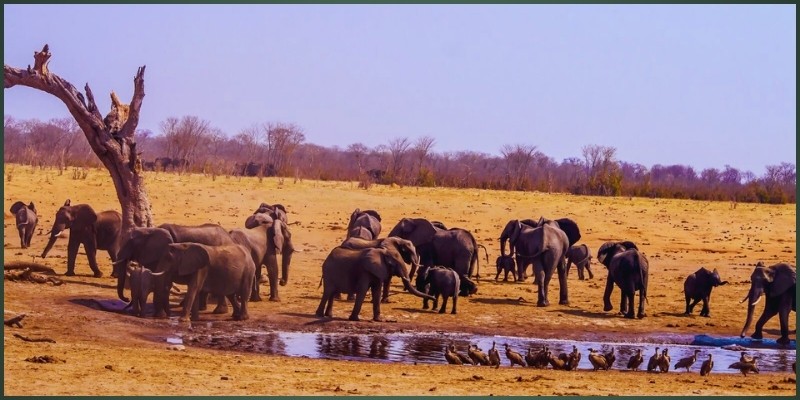Water Bodies and Their Role in Conservation

Hwange National Park is located on the edge of the Kalahari Desert, a region naturally short on perennial rivers. Unlike many African parks, Hwange relies heavily on seasonal rainfall and man-made water systems to support its extraordinary biodiversity.


Natural Pans fill during the rainy season, becoming temporary oases for birds, insects, and amphibians. Widely recognised pans and waterholes in Hwange National Park, across its diverse areas:
- Dopi Pan (in Dopi vlei)
- Kennedy 1 & Kennedy 2 Pans (also known as Massumamalisa/Somalisa)
- Manga Pans (in Manga vlei)
- Nyamandhlovu Pan
- Guvalala Pan
- Dom Pan
- Chivasa Pan
- Longone Pans
- Ngweshla Pan
- Shapi Pan
- Sibaya Pan
- Masuma Dam/Pan
- Mandavu Dam
- Shuma Pans
- Nehimba Pan
- Tshompani Pan
- Dandari (Dandaro) Vlei & Pan
- Kapula Vlei
- Tiriga (Triga) Vlei
- Inkwazi Vlei
- Makololo Pans
- Somavundhla Pan
- Dzivanini (Sibanini) Pan
- Limpandi Dam
- Shakwanki Pan
- Tamasanka Pan
- Xixi Amabandi Pan
- Tsamhole (Tsamahole) Pan
- Bumbumutsa Pan
- Reedbuck Vlei
Man-Made Dams & Waterholes
- Deteema Dam
Located near Robins Camp and Nantwich, supported by three solar-powered boreholes, it’s a key dry-season watering point, especially for elephants, lions, and hippos.
- Masuma Dam (Sinamatella Area)
Equipped with solar-powered pumping and a hide, one of the main artificial waterbodies in the northwest.
- Mandavu Dam (Sinamatella Area)
Another central dry-season dam with a picnic site, maintained via boreholes and solar pumps.
- New Inyantue Dam and Tshompani Dam
Both stocked using borehole-fed water systems in the Sinamatella area.
- Limpandi Dam (Dzivanini Wilderness)
Serviced by one or more boreholes, located near Dzivanini Camp.
Borehole Network (Solar-Powered)
- 104+ solar-powered boreholes across the park
Installed by ZimParks, most are solar-powered, two are mains-electricity - pumping at night with battery backup → ensuring year-round water access.
- Friends of Hwange & Bhejane Trust boreholes
Multiple installations with solar pumps at key pans (e.g., Kennedy 2 Pan), some with back-up generators for nighttime pumping.
- Global Humane / Water for Wildlife initiative
Maintains and monitors borehole-fed pans such as Dom Pan, Nyamandhlovu Pan, Guvalala Pan, Shapi Pan, and Boss Long One, three of these have dual solar pumps, two have single pumps plus battery storage.
- Bhejane Trust network (2016)
Operated ~34 boreholes with emerging solar/wind setups, pumping over a million liters daily during droughts.
Water doesn’t only sustain animals, it sustains people. Nearby communities rely on shared water sources for livestock and agriculture. Traditional knowledge about seasonal water patterns and sacred springs forms a valuable part of Hwange’s cultural heritage.

